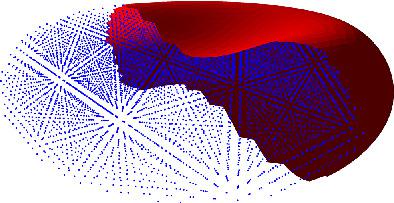当前位置:
X-MOL 学术
›
Int. J. Numer. Methods Fluids
›
论文详情
Our official English website, www.x-mol.net, welcomes your feedback! (Note: you will need to create a separate account there.)
Efficient viscosity contrast calculation for blood flow simulations using the lattice Boltzmann method
International Journal for Numerical Methods in Fluids ( IF 1.8 ) Pub Date : 2020-04-15 , DOI: 10.1002/fld.4835 Moritz Lehmann 1 , Sebastian Johannes Müller 1 , Stephan Gekle 1
International Journal for Numerical Methods in Fluids ( IF 1.8 ) Pub Date : 2020-04-15 , DOI: 10.1002/fld.4835 Moritz Lehmann 1 , Sebastian Johannes Müller 1 , Stephan Gekle 1
Affiliation

|
The lattice Boltzmann method (LBM) combined with the immersed boundary method is a common tool to simulate the movement of red blood cel ls (RBCs) through blood vessels. With very few exceptions, such simulations neglect the difference in viscosities between the hemoglobin solution inside the cells and the blood plasma outside, although it is well known that this viscosity contrast can severely affect cell deformation. While it is easy to change the local viscosity in LBM, the challenge is to distinguish whether a given lattice point is inside or outside the RBC at each time step. Here, we present a fast algorithm to solve this issue by tracking the membrane motion and computing the scalar product between the local surface normal and the distance vector between the closest LBM lattice point and the surface. This approach is much faster than, for example, the ray‐casting method. With the domain tracking applied, we investigate the shape transition of a RBC in a microchannel for different viscosity contrast and validate our method by comparing with boundary‐integral simulations.
中文翻译:

使用格子Boltzmann方法进行血流模拟的有效粘度对比计算
格子玻尔兹曼法(LBM)与浸入边界法相结合是模拟红细胞通过血管运动的常用工具。除了极少数例外,这种模拟忽略了细胞内部血红蛋白溶液与外部血浆之间的粘度差异,尽管众所周知,这种粘度对比会严重影响细胞变形。尽管很容易更改LBM中的局部粘度,但挑战在于区分每个时间步长上给定的晶格点是在RBC的内部还是外部。在这里,我们提出了一种快速算法来解决此问题,方法是跟踪膜的运动并计算局部表面法线与最近的LBM晶格点与表面之间的距离矢量之间的标量积。这种方法比 例如,射线投射法。通过应用域跟踪,我们研究了微通道中RBC在不同粘度对比下的形状转变,并通过与边界积分模拟进行比较来验证我们的方法。
更新日期:2020-04-15
中文翻译:

使用格子Boltzmann方法进行血流模拟的有效粘度对比计算
格子玻尔兹曼法(LBM)与浸入边界法相结合是模拟红细胞通过血管运动的常用工具。除了极少数例外,这种模拟忽略了细胞内部血红蛋白溶液与外部血浆之间的粘度差异,尽管众所周知,这种粘度对比会严重影响细胞变形。尽管很容易更改LBM中的局部粘度,但挑战在于区分每个时间步长上给定的晶格点是在RBC的内部还是外部。在这里,我们提出了一种快速算法来解决此问题,方法是跟踪膜的运动并计算局部表面法线与最近的LBM晶格点与表面之间的距离矢量之间的标量积。这种方法比 例如,射线投射法。通过应用域跟踪,我们研究了微通道中RBC在不同粘度对比下的形状转变,并通过与边界积分模拟进行比较来验证我们的方法。



























 京公网安备 11010802027423号
京公网安备 11010802027423号